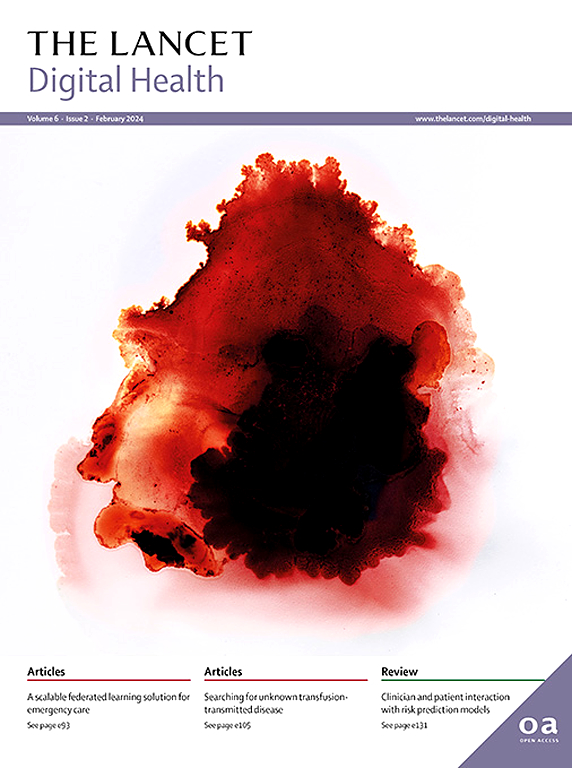人工智能乳房x线摄影筛查试验(MASAI)中检测到的乳腺癌筛查表现和特征:一项随机、对照、平行组、非劣效性、单盲、筛查准确性的研究。
IF 23.8
1区 医学
Q1 MEDICAL INFORMATICS
引用次数: 0
摘要
背景:越来越多的证据表明,人工智能(AI)可以增加乳房x光筛查中的癌症检测,同时减少筛查阅读工作量,但需要进一步了解其临床影响。方法:在瑞典国家筛查项目中进行的这项随机、对照、平行组、非自卑、单盲、筛查准确性研究中,在瑞典西南部(Malmö、Lund、Landskrona和Trelleborg)的四个筛查点招募的符合乳房x光检查条件的妇女被随机分配(1:1)到人工智能支持的筛查或标准双读组。人工智能系统(Transpara version 1.7.0 ScreenPoint Medical, Nijmegen, Netherlands)用于筛选检查的单次或双次阅读,并作为突出可疑发现的检测支持。这是一项针对回忆、癌症检测、假阳性率、回忆阳性预测值、检测到的癌症类型和分期以及屏幕阅读工作量等次要结局指标的协议定义分析。该试验已在ClinicalTrials.gov注册,编号NCT04838756,并已结束累积。研究结果:在2021年4月12日至2022年12月7日期间,109534名女性被随机分配到干预组或对照组。19名女性被排除在分析之外。中位年龄53.7岁(IQR 46.5 ~ 63.2)。在53043名参与者中,人工智能支持的筛查导致338例癌症检测和1110例召回。在52872名参与者中进行标准筛查,发现了262例癌症,并召回了1027例。干预组的癌症检出率为6.4% / 1000 (95% CI为5.7 - 7.1),对照组为5.0 / 1000(4.4 - 5.6),两者之比为1.29 (95% CI为1.09 - 1.51;p = 0·0021)。人工智能支持的筛查导致侵袭性癌症的检出率增加(270例对217例,比例比为1.24 [95% CI 1.04 -1·48]),主要是小淋巴结阴性癌症(T1增加58例,淋巴结阴性增加46例,非腔内a增加21例)。人工智能支持的筛查还导致原位癌的检出率增加(68例对45例,比例比为1.51[1.03 -2·19]),增加的检出率中约有一半是高级别原位癌(核III级12例,核III级12例)。干预组的召回率和假阳性率无显著升高(比值为1.08 [95% CI 0.99 ~ 1.17;P =0·084]和1·01[0·91-1·11;分别为p = 0·92])。干预组回忆性阳性预测值显著高于对照组,比值为1.19 (95% CI 1.04 - 1.37;p = 0·012)。干预组的屏幕阅读次数为61 248次,对照组为109 692次,屏幕阅读工作量减少了44.2%。研究结果表明,人工智能有助于临床相关乳腺癌的早期发现,并在不增加假阳性的情况下减少筛查工作量。资助:瑞典癌症协会,区域癌症中心联合会,瑞典政府资助临床研究。本文章由计算机程序翻译,如有差异,请以英文原文为准。
Screening performance and characteristics of breast cancer detected in the Mammography Screening with Artificial Intelligence trial (MASAI): a randomised, controlled, parallel-group, non-inferiority, single-blinded, screening accuracy study
Background
Emerging evidence suggests that artificial intelligence (AI) can increase cancer detection in mammography screening while reducing screen-reading workload, but further understanding of the clinical impact is needed.
Methods
In this randomised, controlled, parallel-group, non-inferiority, single-blinded, screening-accuracy study, done within the Swedish national screening programme, women recruited at four screening sites in southwest Sweden (Malmö, Lund, Landskrona, and Trelleborg) who were eligible for mammography screening were randomly allocated (1:1) to AI-supported screening or standard double reading. The AI system (Transpara version 1.7.0 ScreenPoint Medical, Nijmegen, Netherlands) was used to triage screening examinations to single or double reading and as detection support highlighting suspicious findings. This is a protocol-defined analysis of the secondary outcome measures of recall, cancer detection, false-positive rates, positive predictive value of recall, type and stage of cancer detected, and screen-reading workload. This trial is registered at ClinicalTrials.gov, NCT04838756 and is closed to accrual.
Findings
Between April 12, 2021, and Dec 7, 2022, 105 934 women were randomly assigned to the intervention or control group. 19 women were excluded from the analysis. The median age was 53·7 years (IQR 46·5–63·2). AI-supported screening among 53 043 participants resulted in 338 detected cancers and 1110 recalls. Standard screening among 52 872 participants resulted in 262 detected cancers and 1027 recalls. Cancer-detection rates were 6·4 per 1000 (95% CI 5·7–7·1) screened participants in the intervention group and 5·0 per 1000 (4·4–5·6) in the control group, a ratio of 1·29 (95% CI 1·09–1·51; p=0·0021). AI-supported screening resulted in an increased detection of invasive cancers (270 vs 217, a proportion ratio of 1·24 [95% CI 1·04–1·48]), wich were mainly small lymph-node negative cancers (58 more T1, 46 more lymph-node negative, and 21 more non-luminal A). AI-supported screening also resulted in an increased detection of in situ cancers (68 vs 45, a proportion ratio of 1·51 [1·03–2·19]), with about half of the increased detection being high-grade in situ cancer (12 more nuclear grade III, and no increase in nuclear grade I). The recall and false-positive rate were not significantly higher in the intervention group (a ratio of 1·08 [95% CI 0·99–1·17; p=0·084] and 1·01 [0·91–1·11; p=0·92], respectively). The positive predictive value of recall was significantly higher in the intervention group compared with the control group, with a ratio of 1·19 (95% CI 1·04–1·37; p=0·012). There were 61 248 screen readings in the intervention group and 109 692 in the control group, resulting in a 44·2% reduction in the screen-reading workload.
Interpretation
The findings suggest that AI contributes to the early detection of clinically relevant breast cancer and reduces screen-reading workload without increasing false positives.
Funding
Swedish Cancer Society, Confederation of Regional Cancer Centres, and Swedish governmental funding for clinical research.
求助全文
通过发布文献求助,成功后即可免费获取论文全文。
去求助
来源期刊

Lancet Digital Health
Multiple-
CiteScore
41.20
自引率
1.60%
发文量
232
审稿时长
13 weeks
期刊介绍:
The Lancet Digital Health publishes important, innovative, and practice-changing research on any topic connected with digital technology in clinical medicine, public health, and global health.
The journal’s open access content crosses subject boundaries, building bridges between health professionals and researchers.By bringing together the most important advances in this multidisciplinary field,The Lancet Digital Health is the most prominent publishing venue in digital health.
We publish a range of content types including Articles,Review, Comment, and Correspondence, contributing to promoting digital technologies in health practice worldwide.
 求助内容:
求助内容: 应助结果提醒方式:
应助结果提醒方式:


